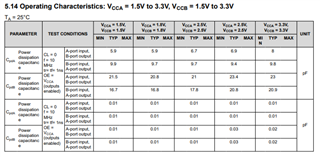Other Parts Discussed in Thread: TXU0304,
Tool/software:
Hi Team,
We are currently evaluating components for our SPI communication line and are considering the TXS0108ERGYR for voltage-level translation between VCCA (1.8V) and VCCB (3V).
To accurately assess its suitability for our application, we kindly request your assistance in providing the following information:
Current Consumption:
Static current consumption at VCCA = 1.8V and VCCB = 3V.
Dynamic current consumption during switching operations, if available.
Any relevant details on current consumption profiles or conditions affecting current draw.
Power Consumption:
Total power consumption under typical operating conditions.
Power consumption breakdown (if available) into components such as quiescent power and dynamic power.
Power Budget Analysis:
Guidance on integrating the TXS0108ERGYR into a power budget analysis.
Any thermal considerations or power dissipation figures that would be relevant to our design.
How to calculate total current and Power ?
Sample Request:
If possible, we would appreciate receiving a sample of the TXS0108ERGYR for evaluation purposes based on the information provided.
We value your expertise and look forward to your prompt response.
Best regards,
Sathiya


